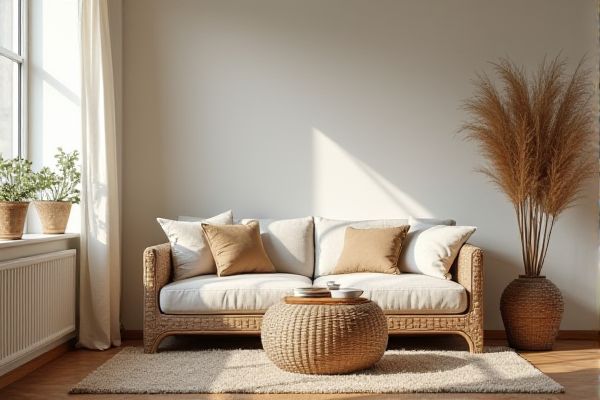
Synthetic wicker offers superior durability and weather resistance compared to natural wicker, making it ideal for outdoor furniture that withstands sun, rain, and humidity without fading or cracking. Discover which material best suits Your lifestyle and aesthetic by exploring the detailed comparisons in the rest of this article.
Table of Comparison
| Feature | Synthetic Wicker | Natural Wicker |
|---|---|---|
| Material | Resin, PVC, or polyethylene fibers | Rattan, bamboo, reed, willow |
| Durability | Weather-resistant, UV-proof, long-lasting | Prone to moisture damage and fading |
| Maintenance | Low; easy to clean with soap and water | High; requires regular cleaning and protection |
| Appearance | Consistent color, modern look | Natural, rustic, unique texture |
| Cost | Moderate to high | Usually lower, but varies by quality |
| Environmental Impact | Manufactured, less eco-friendly | Biodegradable, sustainable if sourced responsibly |
| Use | Outdoor and indoor furniture | Primarily indoor furniture, limited outdoor use |
Introduction to Synthetic and Natural Wicker
Synthetic wicker, made from durable resin fibers, offers superior weather resistance and low maintenance compared to natural wicker derived from rattan or willow plants. Natural wicker provides a traditional, organic aesthetic but tends to be less resistant to moisture, sunlight, and wear over time. Choosing between synthetic and natural wicker depends on balancing durability requirements with the desired texture and environmental impact.
Material Composition: Synthetic vs Natural Wicker
Synthetic wicker is made from polyethylene, resin, or plastic fibers designed to mimic the appearance of natural wicker while offering enhanced durability and weather resistance. Natural wicker consists of plant-based materials such as rattan, willow, or bamboo, which provide a lightweight, eco-friendly option with a traditional aesthetic but tend to be less resistant to moisture and sunlight. Your choice between synthetic and natural wicker should consider the setting and maintenance requirements, as synthetic materials require less upkeep and last longer outdoors.
Durability and Longevity Comparison
Synthetic wicker offers superior durability and resistance to weather elements such as UV rays, moisture, and temperature fluctuations, ensuring longer-lasting outdoor furniture. Natural wicker, made from rattan, willow, or bamboo, tends to deteriorate more quickly when exposed to humidity, sunlight, and rain, requiring regular maintenance to prevent cracking and fading. Synthetic wicker furniture commonly lasts 10-15 years or more, whereas natural wicker typically lasts 3-5 years outdoors without protective care.
Maintenance and Care Requirements
Synthetic wicker requires minimal maintenance, as it is resistant to moisture, UV rays, and pests, making it ideal for outdoor use without special treatments. Natural wicker demands regular care, including dusting, occasional cleaning with mild soap, and protection from prolonged exposure to sunlight and humidity to prevent cracking or mold growth. Your choice should consider the ease of upkeep, with synthetic wicker offering a more durable and low-maintenance option compared to the delicate nature of natural wicker.
Weather Resistance and Outdoor Use
Synthetic wicker offers superior weather resistance compared to natural wicker, as it is made from resin or plastic materials that withstand moisture, UV rays, and temperature fluctuations without degrading. Natural wicker, typically crafted from rattan, bamboo, or willow, tends to absorb water and can deteriorate or mold when exposed to prolonged outdoor conditions. For long-term outdoor use, synthetic wicker furniture is a more durable and low-maintenance option, ensuring longevity in various climates.
Environmental Impact and Sustainability
Synthetic wicker is typically made from polyethylene or resin, making it durable and resistant to moisture but reliant on non-renewable petroleum resources, which contributes to environmental pollution and landfill waste. Natural wicker, sourced from renewable materials like rattan, bamboo, or willow, offers better biodegradability and a lower carbon footprint, though its harvesting must be managed sustainably to prevent deforestation. You can choose natural wicker for an eco-friendly option if durability and low environmental impact are your priorities.
Aesthetic Differences: Texture and Appearance
Synthetic wicker offers a consistent, uniform texture and color that resists fading and weathering, making it ideal for maintaining a polished look over time. Natural wicker features a unique, organic texture with subtle variations and a warm, earthy appearance that ages gracefully, adding character to your furniture. Your choice depends on whether you prefer the sleek, modern finish of synthetic materials or the authentic, artisanal charm of natural wicker.
Cost Comparison: Initial Investment and Lifespan
Synthetic wicker offers a lower initial investment compared to natural wicker, making it a cost-effective option for budget-conscious buyers. It boasts a longer lifespan due to its resistance to weather, moisture, and UV damage, which reduces replacement and maintenance costs over time. Natural wicker, while often pricier upfront, requires regular upkeep and is prone to wear and tear, leading to higher long-term expenses despite its classic aesthetic appeal.
Popular Uses: Indoor and Outdoor Applications
Synthetic wicker is widely favored for outdoor furniture due to its resistance to moisture, UV rays, and temperature fluctuations, making it ideal for patios, gardens, and poolside settings. Natural wicker, crafted from rattan, reed, or bamboo, is commonly used indoors where humidity and exposure to the elements are controlled to prevent damage. Indoor applications for natural wicker include living room chairs and decorative furniture, while synthetic wicker dominates outdoor lounges, dining sets, and weather-resistant accessories.
Choosing the Right Wicker for Your Needs
Synthetic wicker offers superior durability and weather resistance, making it ideal for outdoor furniture exposed to harsh climates. Natural wicker provides authentic texture and breathability, preferred for indoor use or covered outdoor areas. Selecting the right wicker depends on factors like exposure to elements, maintenance requirements, and desired aesthetic.
 homyna.com
homyna.com